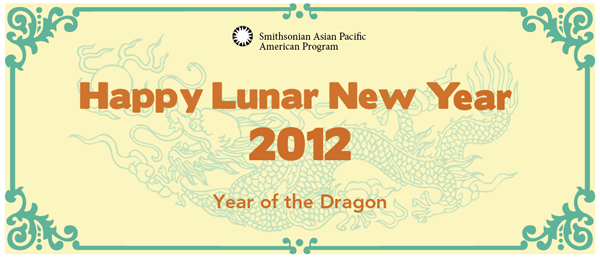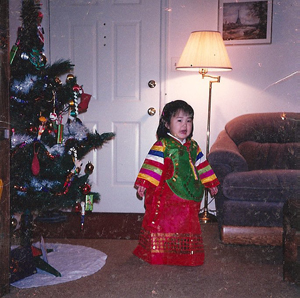Happy Lunar New Year!
We’d like to wish everyone a Happy Lunar New Year 2012 (Year of the Dragon)! Click here to read more about this important event and how it is celebrated among many Asian Pacific American (APA) communities. This year, Smithsonian colleagues Jina Lee (Smithsonian American Art Museum) and Sojin Kim (Center for Folklife and Cultural Heritage) share how they, as Korean Americans, celebrate the Lunar New Year in their homes.
Leave us a comment about how you celebrate the Lunar New Year!
Guest Blog by Jina Lee, Exhibitions Assistant at the Smithsonian American Art Museum
As a Korean American, I’ve had the pleasure of ringing in the New Year, both in the traditional Korean (Eastern) and Western tradition. The Western tradition, as we all know, is the fun filled night of celebrating the last night of the Western calendar—Dec. 31st. In particular, my family will the end of that particular year. We would either go into the city (Washington D.C.) for a nice dinner outing, or stay in and have Mom cook us a delicious dinner of steak or fish. Lastly, we would put on the annual Dick Clark (now Ryan Seacrest) New Years Eve television special, and watch the iconic Time Square ball drop as the massive crowds chant in sync with the countdown. While the Western tradition seems to focus on celebrating the end of the calendar, the following day (January 1) for Korean Americans seems to be the opposite. The focus is more so on starting anew and with a clean slate for the New Year. Our New Years Eve meals were usually so decadent, however on New Years Day, Mom would cook the traditional Korean rice cake and mandu (dumpling) soup for brunch. This soup usually had a beef based broth, lots of fresh rice cakes called dduk and homemade mandu (dumpling) dropped into the soup, along with scallions, egg, seaweed (gim), and slices of beef as garnishes. It was scrumptious!

Young Jina is bowing to her grandparents as a sign of respect and good fortune in the New Year. This Korean tradition is known as sae-bae.
After “cleansing” ourselves with this soup, all the elders in our family would then sit on the floor of our living room to receive their sae-bae bows from the young ones (their children, nephews, nieces, grandchildren, etc.). Sae-bae is a traditional Korean custom of bowing to one’s elder as a sign of respect. As the young ones, we would wish them good fortune in the coming year. We (the young ones again) would usually line up in a row, and do a group sae-bae, as opposed to the embarrassing solo sae-bae, where it was all eyes on you. But with all that embarrassment aside, what is rewarding about the sae-bae is the money you receive from your elders as a sign of good fortune and luck in the coming year. I used to place this money in my little red and gold hand-sewn pouch that came with my han-bok (traditional Korean garments). When I was little, I wasn’t fond of the han-bok material because of all the multiple layers and the different texture from my school clothes. But, the richness of all the different colors on the han-bok were very beautiful even to my little girl eyes. At that time, I probably didn’t realize I was celebrating both my Korean and American heritage, however after 26 years or so, I now realize how special it was to do so. Happy Lunar New Year!
Guest Blog by Sojin Kim, Curator at the Smithsonian Center for Folklife and Cultural Heritage
The translation of traditions from one place to another is of course an imprecise process with its inevitable miscalculations, deprivations, and redundancies. In my family, birthdays are celebrated on days that are vague approximations of lunar calendar coordinates and in some cases downright fabricated dates. No matter, my mother says, in our tradition everyone turns a year older on the first day of the new year, an occasion that we often observe twice.

Left: My mother's version of duk mandu guk, a dish that Koreans typically enjoy to celebrate the new year. Right: Chewy rice cake (duk).
A few weeks ago on January 1, my family convened as usual for our New Year’s meal. We sat down at 10:30 am with glasses of champagne and steaming bowls of duk mandu guk. This year, my mom’s version included both the flat chewy rice cakes and meat dumplings, strips of fried egg and marinated beef, kimchi, and a few slices of Japanese shishito pepper (standing in for the green onions that she had forgotten to buy). The key ingredient is the duk (rice cake)—eating it on New Year’s, I’ve been assured, is good luck.
Later in the day, my family gathered around for a second, less formal meal. We heaped our plates with marinated ribs, sautéed vegetables, battered shrimp and fish, stuffed peppers, and more kimchi. This bounty, wrapped carefully in old takeout containers and aluminum foil, was delivered from an old family friend, who had prepared and offered the spread to the ancestors earlier in the day. Every year, we get their leftovers, and we feast for days on these, even as our own ancestors go hungry.
In a week or so, as the Lunar Year of the Dragon kicks off, my family will sit down again for duk mandu guk. We may or may not make it ourselves—very likely we’ll go to a restaurant. In either case, we figure, one can never have too much good luck.





My family doesn’t celebrate Lunar New Year but I believe this is like Christmas for Christians wherein this is a time for family reunion.
I have Korean and Taiwanese friends who are celebrating Lunar New Year. And they always mention that this is the happiest season of the year for them. They also mentioned about special foods they always prepare during this time.